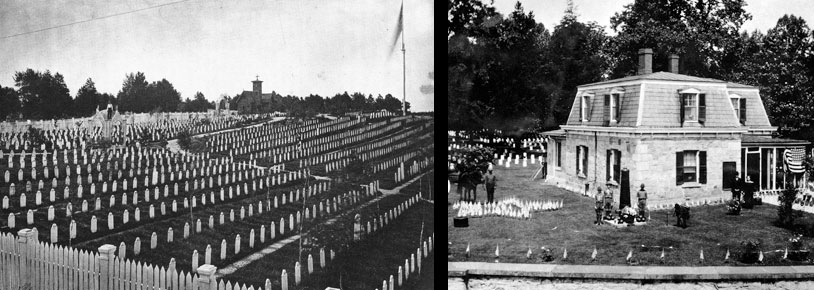

Civil War Era National Cemeteries: Honoring Those Who Served
Nashville National Cemetery
Madison, Tennessee
 |
| Monumental arch, Nashville National Cemetery Courtesy of the Department of Veterans Affairs, National Cemetery Administration, History Program |
Although Tennessee seceded from the Union, Union troops retained control of Nashville for most of the Civil War. The city’s location along the Cumberland River and its railroad links made it an important supply depot for Union campaigns throughout the South. Retaking Nashville became a major objective of the Confederacy, and in December 1864, Lieutenant General John B. Hood and his 19,000 troops took up a position southeast of the city. However, Union troops, led by Major General George H. Thomas, had overwhelming numbers and two lines of defense set up outside the city. During the Battle of Nashville on December 14 to 16, 1864, Union troops overran Hood’s forces from three sides, forcing their retreat. The battle resulted in 6,000 casualties for Confederate troops and approximately 3,600 for the Union.
The need to bury casualties from the Battle of Nashville, other skirmishes from central Tennessee, and several hospitals in town, created the impetus for the Nashville National Cemetery. General Thomas helped choose the site, ultimately selecting a location that sat on both the Louisville and Nashville Railroad and Gallatin Pike. Thomas said of the site, “no one could come to Nashville from the north and not be reminded of the sacrifices that had been made for the preservation of the Union.”
The cemetery opened in July 1866. Most of the original burials were reinterments from temporary hospital burying grounds and battlefield graves from Nashville, Franklin, and Gallatin, Tennessee and Bowling Green and Cave City, Kentucky. The graves are laid out in irregular sections between curvilinear avenues. The cemetery closed to new interments in 1993.
Nashville National Cemetery is square in shape, covering nearly 64 acres. The cemetery is bisected by the Louisville and Nashville Railroad, which runs roughly north and south through the site. In the center of the cemetery, a tunnel beneath the railroad tracks connects the east and west halves of the grounds. Along Gallatin Road, a dramatic limestone archway built in 1870 marks the cemetery’s main entrance. The arch, the oldest in the national cemetery system, is 32 feet tall and 26 feet wide, and is similar to other entry arches at Marietta, Chattanooga, Vicksburg, and Arlington National Cemeteries. Wrought-iron fencing and a limestone block wall make up the cemetery eastern boundary, while limestone rubble walls demarcate the remaining sides.
 |
USCT Monument, Nashville National Cemetery Courtesy of the Department of Veterans Affairs, National Cemetery Administration, History Program |
One of the most notable monuments at the cemetery is the Minnesota Monument, which the state of Minnesota erected in 1920 in honor of Minnesota Civil War soldiers buried here. The bronze female figure is located in Section MM. One of the cemetery’s newest monuments, dedicated to the United States Colored Troops, was erected in 2006.
Other site features include five upright seacoast cannons located throughout the cemetery. Affixed to one of the guns is an 1874 shield plaque with the cemetery's name, date of establishment and the number of known and unknown interments.
Nashville National Cemetery is the final resting place for three recipients of the Medal of Honor, the nation’s highest military decoration, given for “conspicuous gallantry and intrepidity at the risk of his life above and beyond the call of duty.”
| Plan your visit |
Nashville National Cemetery is located at 1420 Gallatin Road, South, in Madison, TN. The cemetery is open for visitation daily from dawn until dusk. The administrative office is open Monday to Friday from 8:00am to 4:30pm, and is closed on all Federal holidays except for Memorial Day. For more information, please contact the cemetery office at 615-860-0086, or see the Department of Veterans Affairs website. While visiting, please be mindful that our national cemeteries are hallowed ground. Be respectful to all of our nation’s fallen soldiers and their families. Additional cemetery policies may be posted on site. Nashville National Cemetery lies within the Tennessee Civil War National Heritage Area. Nashville National Cemetery was photographed to the standards established by the National Park Service’s Historic American Landscapes Survey. |